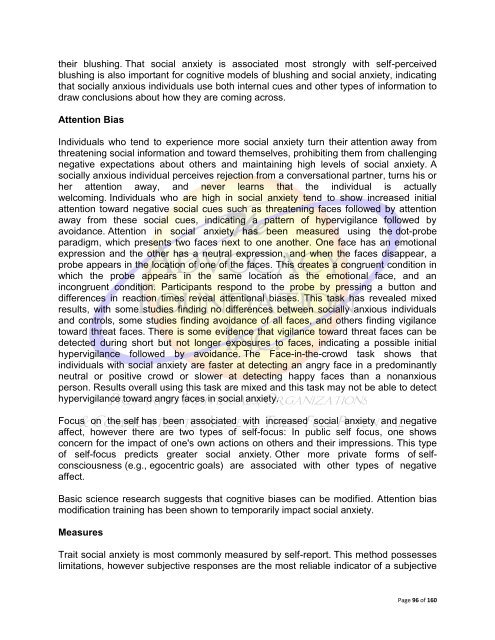The Gift of Introversion
The Gift of Introversion
The Gift of Introversion
Create successful ePaper yourself
Turn your PDF publications into a flip-book with our unique Google optimized e-Paper software.
their blushing. That social anxiety is associated most strongly with self-perceived<br />
blushing is also important for cognitive models <strong>of</strong> blushing and social anxiety, indicating<br />
that socially anxious individuals use both internal cues and other types <strong>of</strong> information to<br />
draw conclusions about how they are coming across.<br />
Attention Bias<br />
Individuals who tend to experience more social anxiety turn their attention away from<br />
threatening social information and toward themselves, prohibiting them from challenging<br />
negative expectations about others and maintaining high levels <strong>of</strong> social anxiety. A<br />
socially anxious individual perceives rejection from a conversational partner, turns his or<br />
her attention away, and never learns that the individual is actually<br />
welcoming. Individuals who are high in social anxiety tend to show increased initial<br />
attention toward negative social cues such as threatening faces followed by attention<br />
away from these social cues, indicating a pattern <strong>of</strong> hypervigilance followed by<br />
avoidance. Attention in social anxiety has been measured using the dot-probe<br />
paradigm, which presents two faces next to one another. One face has an emotional<br />
expression and the other has a neutral expression, and when the faces disappear, a<br />
probe appears in the location <strong>of</strong> one <strong>of</strong> the faces. This creates a congruent condition in<br />
which the probe appears in the same location as the emotional face, and an<br />
incongruent condition. Participants respond to the probe by pressing a button and<br />
differences in reaction times reveal attentional biases. This task has revealed mixed<br />
results, with some studies finding no differences between socially anxious individuals<br />
and controls, some studies finding avoidance <strong>of</strong> all faces, and others finding vigilance<br />
toward threat faces. <strong>The</strong>re is some evidence that vigilance toward threat faces can be<br />
detected during short but not longer exposures to faces, indicating a possible initial<br />
hypervigilance followed by avoidance. <strong>The</strong> Face-in-the-crowd task shows that<br />
individuals with social anxiety are faster at detecting an angry face in a predominantly<br />
neutral or positive crowd or slower at detecting happy faces than a nonanxious<br />
person. Results overall using this task are mixed and this task may not be able to detect<br />
hypervigilance toward angry faces in social anxiety.<br />
Focus on the self has been associated with increased social anxiety and negative<br />
affect, however there are two types <strong>of</strong> self-focus: In public self focus, one shows<br />
concern for the impact <strong>of</strong> one's own actions on others and their impressions. This type<br />
<strong>of</strong> self-focus predicts greater social anxiety. Other more private forms <strong>of</strong> selfconsciousness<br />
(e.g., egocentric goals) are associated with other types <strong>of</strong> negative<br />
affect.<br />
Basic science research suggests that cognitive biases can be modified. Attention bias<br />
modification training has been shown to temporarily impact social anxiety.<br />
Measures<br />
Trait social anxiety is most commonly measured by self-report. This method possesses<br />
limitations, however subjective responses are the most reliable indicator <strong>of</strong> a subjective<br />
Page 96 <strong>of</strong> 160

















